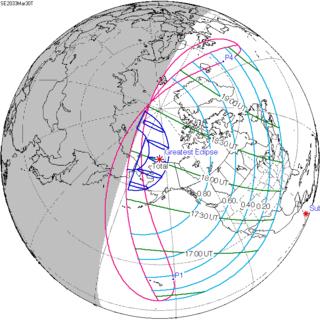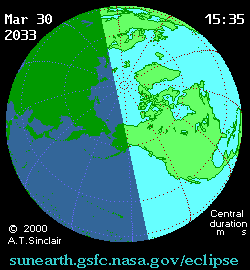Solar eclipse of March 30, 2033
| Solar eclipse of March 30, 2033 | |
|---|---|
| Type of eclipse | |
| Nature | Total |
| Gamma | 0.9778 |
| Magnitude | 1.0462 |
| Maximum eclipse | |
| Duration | 157 s (2 min 37 s) |
| Coordinates | 71°18′N 155°48′W / 71.3°N 155.8°W |
| Max. width of band | 781 km (485 mi) |
| Times (UTC) | |
| Greatest eclipse | 18:02:36 |
| References | |
| Saros | 120 (62 of 71) |
| Catalog # (SE5000) | 9581 |
A total solar eclipse will occur on Wednesday, March 30, 2033. A solar eclipse occurs when the Moon passes between Earth and the Sun, thereby totally or partly obscuring the image of the Sun for a viewer on Earth. A total solar eclipse occurs when the Moon's apparent diameter is larger than the Sun's, blocking all direct sunlight, turning day into darkness. Totality occurs in a narrow path across Earth's surface, with the partial solar eclipse visible over a surrounding region thousands of kilometres wide.
Totality will be visible in Nome, Alaska, Utqiaġvik, Alaska and the Chukchi Peninsula in the mid-morning hours. This is the last of 55 umbral eclipses of Solar Saros 120. The first was in 1059. The total duration is 974 years.
Images[edit]
Related eclipses[edit]
The eclipse is a member of a semester series of solar eclipses that repeat approximately every 177 days and 4 hours (a semester) at alternating nodes of the Moon's orbit.[1] It is also part of Saros cycle 120, repeating every 18 years, 11 days, containing 71 events.
References[edit]
- ^ van Gent, R.H. "Solar- and Lunar-Eclipse Predictions from Antiquity to the Present". A Catalogue of Eclipse Cycles. Utrecht University. Archived from the original on September 7, 2019. Retrieved 6 October 2018.





